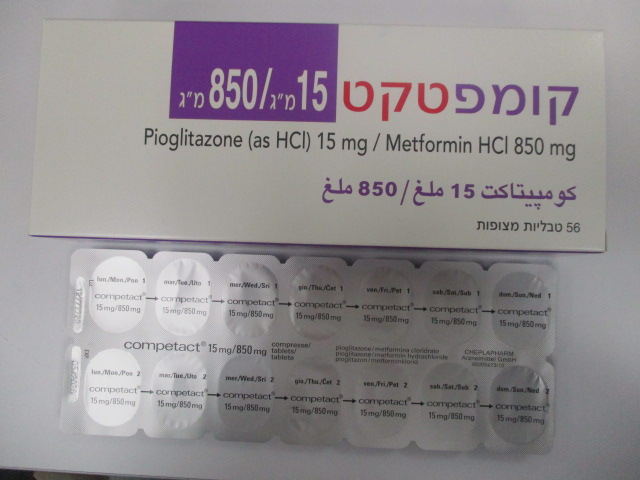Quest for the right Drug

קומפטקט 15 מ"ג / 850 מ"ג COMPETACT 15 MG / 850 MG (METFORMIN HYDROCHLORIDE, PIOGLITAZONE AS HYDROCHLORIDE)
תרופה במרשם
תרופה בסל
נרקוטיקה
ציטוטוקסיקה
צורת מתן:
פומי : PER OS
צורת מינון:
טבליות מצופות פילם : FILM COATED TABLETS
עלון לרופא
מינוניםPosology התוויות
Indications תופעות לוואי
Adverse reactions התוויות נגד
Contraindications אינטראקציות
Interactions מינון יתר
Overdose הריון/הנקה
Pregnancy & Lactation אוכלוסיות מיוחדות
Special populations תכונות פרמקולוגיות
Pharmacological properties מידע רוקחי
Pharmaceutical particulars אזהרת שימוש
Special Warning עלון לרופא
Physicians Leaflet
Interactions : אינטראקציות
4.5 Interaction with other medicinal products and other forms of interaction There have been no formal interaction studies for Competact. The following statements reflect the information available on the individual active substances (pioglitazone and metformin). Metformin Concomitant use not recommended Alcohol Alcohol intoxication is associated with an increased risk of lactic acidosis, particularly in case of fasting, malnutrition or hepatic impairment. Iodinated contrast agents Competact must be discontinued prior to or at the time of the imaging procedure and not restarted until at least 48 hours after, provided that renal function has been re-evaluated and found to be stable, see sections 4.2 and 4.4. Combinations requiring precautions for use Some medicinal products that can adversely affect renal function which may increase the risk of lactic acidosis, e.g. NSAIDS, including selective cyclo-oxygenase (COX) II inhibitors, angiotensin-converting enzyme (ACE) inhibitors, angiotensin II receptor antagonists and diuretics, especially loop diuretics. When starting or using such products in combination with Competact, close monitoring of renal function is necessary. Cationic medicinal products that are eliminated by renal tubular secretion (e.g. cimetidine) may interact with metformin by competing for common renal tubular transport systems. A study conducted in seven normal healthy volunteers showed that cimetidine, administered as 400 mg twice daily, increased metformin systemic exposure (AUC) by 50% and Cmax by 81%. Therefore, close monitoring of glycaemic control, dose adjustment within the recommended posology and changes in diabetic treatment should be considered when cationic medicinal products that are eliminated by renal tubular secretion are co-administered. Pioglitazone Co-administration of pioglitazone with gemfibrozil (an inhibitor of cytochrome P450 2C8) is reported to result in a 3-fold increase in AUC of pioglitazone. Since there is a potential for an increase in dose-related adverse events, a decrease in the dose of pioglitazone may be needed when gemfibrozil is concomitantly administered. Close monitoring of glycaemic control should be considered (see section 4.4). Co-administration of pioglitazone with rifampicin (an inducer of cytochrome P450 2C8) is reported to result in a 54% decrease in AUC of pioglitazone. The pioglitazone dose may need to be increased when rifampicin is concomitantly administered. Close monitoring of glycaemic control should be considered (see section 4.4). Glucocorticoids (given by systemic and local routes), beta-2-agonists, and diuretics have intrinsic hyperglycaemic activity. The patient should be informed and more frequent blood glucose monitoring performed, especially at the beginning of treatment. If necessary, the dose of the antihyperglycaemic medicinal product should be adjusted during therapy with the other medicinal product and on its discontinuation. ACE-inhibitors may decrease the blood glucose levels. If necessary, the dose of the antihyperglycaemic medicinal product should be adjusted during therapy with the other medicinal product and on its discontinuation. Interaction studies have shown that pioglitazone has no relevant effect on either the pharmacokinetics or pharmacodynamics of digoxin, warfarin, phenprocoumon and metformin. Studies in man suggest no induction of the main inducible cytochrome P450, 1A, 2C8/9 and 3A4. In vitro studies have shown no inhibition of any subtype of cytochrome P450. Interactions with substances metabolised by these enzymes, e.g. oral contraceptives, cyclosporin, calcium channel blockers, and HMGCoA reductase inhibitors are not to be expected.

שימוש לפי פנקס קופ''ח כללית 1994
לא צוין
תאריך הכללה מקורי בסל
לא צוין
הגבלות
לא צוין
מידע נוסף
